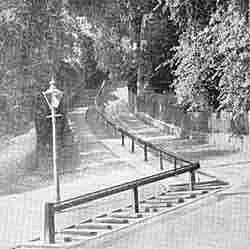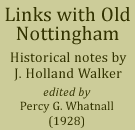< Previous | Contents | Next >
The Park Steps
 |
PARK STEPS are often admired for their picturesqueness, and certainly when the trees in the neighbourhood are in full foliage this admiration is justified.
But of the hundreds of people whose minds are thus filled with admiration there are few who realise the historic significance of Park Steps, or the fact that Park Steps, a portion of Park Valley and Lenton-road, are public footpaths, and cannot be closed to the public as the rest of the Park may be.
To understand how all this came about we must cast our minds back many hundreds of years to the time when Nottingham was a small fortified village clustering round where St. Mary’s Church now stands. This village was surrounded by open lands across which meandered tracks and roads leading from neighbouring settlements to the gates of Nottingham’s fortification.
One of these gateways is represented to-day by Byard-lane, and from it a track leads westward, keeping on the firm ground at the summit of the ridge of sandstone that runs across the Park, and this is represented by Pepper-street, Hounds-gate, Lenton-road, Sherwin-road and Cut Through-lane. It must be one of the oldest tracks in the neighbourhood, and its age is so great that it cannot be computed in terms of years.
In 1068 William I. built his castle upon the Castle Rock, and this trackway passed uncomfortably near to his fortifications. Little by little the size and importance of this castle increased until in Henry III.’s reign it reached as far as what we call Park-row.
Manifestly a public road could not be permitted to cross its area, and as public rights of way were not of much account in those days, the roadway was interrupted. Traffic still had to pass, however, and gradually a fresh route was formed more or less along Postern-street and the upper part of Park-row. To join this new route with the old Lenton-road route it was necessary to struggle down the precipice, and so Park Steps came to be formed.
This route could never have been suitable for horses and was, in fact, only a footway and that is why there is a public footway, but no carriage way through certain roads in the Park.
The cutting through the rock making a direct roadway into the Park from the Castle Gateway was excavated in 1828.
